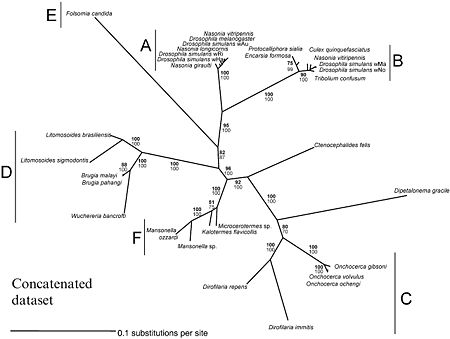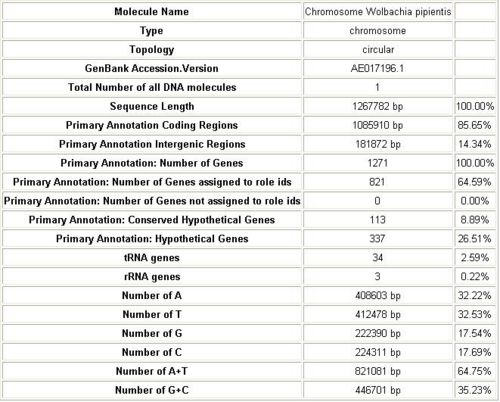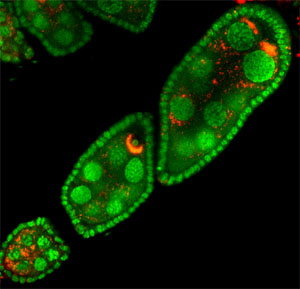Wolbachia pipientis
A Microbial Biorealm page on the genus Wolbachia pipientis

Classification
Higher Order Taxa
Bacteria; Proteobacteria; Alphaproteobacteria; Rickettsiales; Rickettsiaceae; Wolbachieae; Wolbachia
Species
Wolbachia pipientis
|
NCBI: Taxonomy Genome: - Wolbachia pipientis wMel |
Genus species
Description and Significance
Wolbachia pipientis are bacteria that infect a wide range of invertebrate, mainly arthropods and numerous insects. Wolbachia is one of the most common pathogens on Earth that infect the reproductive system of insects; it is estimated with more than 18% of insects are infected by it including spider, mosquito, and flies. These gram-negative bacteria give various physical characteristics of its infection. The infection causes a variety of result including deterring chromosomal sex determination from gamete fertilization. Also, it may initiate parthenogenesis that causes growth and development without fertilization by sperm because it can selectively kill males; thus, it creates a detrimental competition against sperm and causes cytoplasmic incompatibility in fertilized eggs. Although the types of hosts that Wolbachia infect are insignificant, their uniqueness in altering reproduction has caught many scientist to research the biology of infection and their potential use for controlling pest and pathosis.
Genome Structure
From further observation of the genomic structure, analyzing the different types of bacterial nucleus, has unfold the many mystery of biology and evolution of the bacteria. For instance, orthologous genes that are unique from bacteria of the same genus show a pattern of genetic divergence. Different species of the same genus have a closely related DNA sequences with the same repetitiveness and mobile elements. According to a research, this observation, in conjunction with evolutionary dogma, gives an impression that natural selection may somehow ineffective because of population bottleneck.
Cell Structure and Metabolism
Genome analysis predicts many metabolic differences with the closely related Rickettsia species, including the presence of intact glycolysis and purine synthesis, which may compensate for an inability to obtain ATP directly from its host, as Rickettsia can. Other discoveries include the apparent inability of Wolbachia to synthesize lipopolysaccharide.
Ecology
Despite the ability of Wolbachia to infect the germline of its host, no evidence has yet been found for either recent lateral gene transfer between Wolbachia and D. melanogaster or older transfers between Wolbachia and any host. Evolutionary analysis further supports the hypothesis that mitochondria share a common ancestor with the alpha-Proteobacteria, but shows little support for the grouping of mitochondria with species in the order Rickettsiales.
Pathology
Wolbachia is a parasitic bacteria that infects reproductive system of insects which ultimately affects their linage continuation. The symbiosis between the bacteria and host is complex. Depending on the interaction, it ranges from mutualism to parasitism. The bacteria infect different types of organ, but the remarkable characteristic is their ability to alter the way maternal genes are passed on to the next generation by infecting the testes and ovaries of their hosts. There are four different phenotypes expressed:
- male killing (death of infected males). This selectively allows females to survive and more likely to reproduce even in the absence of males.
- feminization (infected males grow as either fully fertile females or infertile pseudo-females)
- parthenogenesis(reproduction of infected females asexually)
- Cytoplasmic incompatibility (the inability of Wolbachia-infected males to successfully reproduce with uninfected females). This method causes a certain Wolbachia strain to be more dominant over the others.
Furthermore, Wolbachia are not found in mature sperms, but are found in mature eggs. So, the infection is carried along to offspring by infected females but not males.
Application to Biotechnology
Does this organism produce any useful compounds or enzymes? What are they and how are they used?
Current Research
- The bacteria were first identified in 1924 by Hertig and Wolbach in Culex pipiens, a species of mosquito
- Research by Sullivan uncovers modus operandi of parasitic bacterium in insects
- Interaction of Drosophila and its endosymbiont Wolbachia: natural heat shock and the overcoming of sexual incompatibility
- Using Wolbachia to reduce virus transmission: Toward the genetic manipulation of crop pests
References
Description and Significance:
Genome Structure
Pathology
Current Research
- M. Hertig & S. B. Wolbach (1924). "Studies on Rickettsia-like microorganisms in insects". Journal of Medical Research 44: 329–374
- Research by Sullivan
- Interaction of Drosophila and its endosymbiont Wolbachia
- Using Wolbachia to reduce virus transmission


